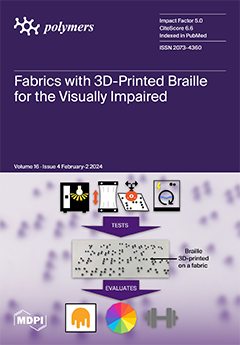CO
2 capture, applied in CO
2 separation from natural gas or in CO
2/N
2 separation from power plant flue gas streams, is of great importance for technical, economic, and environmental reasons. The latter seems important because CO
2, as a greenhouse gas, is considered the main contributor to global warming. Using polymeric membranes for CO
2 separation presents several advantages, such as low energy demand, small equipment volume, and the absence of liquid waste. In this study, two ionic liquids (ILs) were used for the preparation of cellulose acetate (CA)–IL blend membranes for potential CO
2 capture applications, namely, 1-butyl-3-methylimidazolium hydrogen sulfate (
[
]) and choline glycine (
), as they present adequate CO
2 dissolution ability. The first IL is commercially available, whereas the latter was synthesized by a novel route. Several composite membranes were prepared through the solvent casting technique and characterized by a variety of methods, including thermogravimetry, calorimetry, FTIR spectroscopy, and X-ray diffraction. The CO
2 sorption in the composite membranes was experimentally measured using the mass loss analysis (MLA) technique. The results showed that the ILs strongly interacted with the C=O groups of CA, which exhibited high affinity with CO
2. In the case of
[
], a reduction in the available sites that allow strong intermolecular interactions with CO
2 resulted in a decrease in CO
2 sorption compared to that of pure CA. In the case of
, the reduction was balanced out by the presence of specific groups in the IL, which presented high affinity with CO
2. Thus, the CA-
blend membranes exhibited increased CO
2 sorption capability, in addition to other advantages such as non-toxicity and low cost.
Full article


